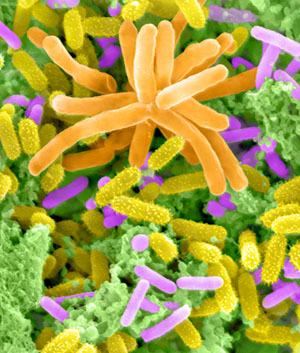Methylotenera sp. SIP3-4 has changed names to Methylovorus sp. SIP3-4 on 6/17/09. The proposed project is an offspring of a previous CSP collaboration between JGI and our group at University of Washington that was directed at uncovering the identities of organisms actively involved in utilization of single-carbon (C1) compounds, important constituents of global carbon and nitrogen cycling, in our study site, Lake Washington, as a model environment. The strategy we employed involved C1 substrate-specific stable isotope probing (SIP) to label DNA of target populations, followed by whole genome shotgun sequencing of the labeled DNA. This approach allowed for increased sequence coverage for functionally active microbes in the 255 Mb metagenomic dataset resulting from this project. 16S rRNA gene analysis indicated that some of the most highly covered genomes in this dataset belonged to Methylotenera species closely related to M. mobilis, a bacterium we recently isolated from Lake Washington. A total of 10 phylotypes were detected, with coverage of up to 20X, highlighting importance of Methylotenera in cycling of C1 compounds in Lake Washington and potentially globally. Comparative analysis of Methylotenera sequences enriched on different C1 substrates suggested that, while closely related phylogenetically, different strains may be metabolically diverse. More recently we isolated two new strains of Methylotenera that differ in their substrate specialization from M. mobilis. Genomes of the three cultivated strains are proposed to be shotgun sequenced, assembled and finished, and compared to the fragmented genomes of environmental Methylotenera strains, to better understand their metabolic roles in global cycles of carbon and nitrogen. Relevance to the DOE mission Methylotrophs are of interest to the following DOE-supported Biological and Environmental Research programs: the Climate Change Research Program, as key participants in maintaining the levels of major green-house gases such as methane, CO2, N2O2 and dimethylsufide (DMS) in the atmosphere; the Natural and Accelerated Bioremediation Research Program, as agents in bioremediation of such hazardous pollutants as MTBE, trichloroethylene and other halogenated methanes; the Environmental Management Science Program, as major players in global cycling of carbon, nitrogen and sulfur, and agents in bioremediation of environmental pollutants such as chlorinated solvents; the Microbial Genome Program as representatives of microbial groups that have evolved to specialize in a specific metabolic mode and, respectively, life style, such as dependence on C1 compounds; the Ocean Science Program, as major players in methane, methanol, methylated amines, DMS and formaldehyde consumption in oceans; and the Genomics: GTL Program as carriers of specific enzyme and regulatory systems allowing unique biochemical transformation capacities important to DOE missions, such as inexpensive and efficient environmental clean-up, biodegradable plastic production potential etc.
Ludmila Chistoserdova, Marina G. Kalyuzhnaya, and Alla Lapidus, Community Sequencing Program: Project Proposal, Metabolic versatility of Methylotenera species and their role in global carbon and nitrogen cycles. |
||
|
||
Methylovorus sp. SIP3-4

